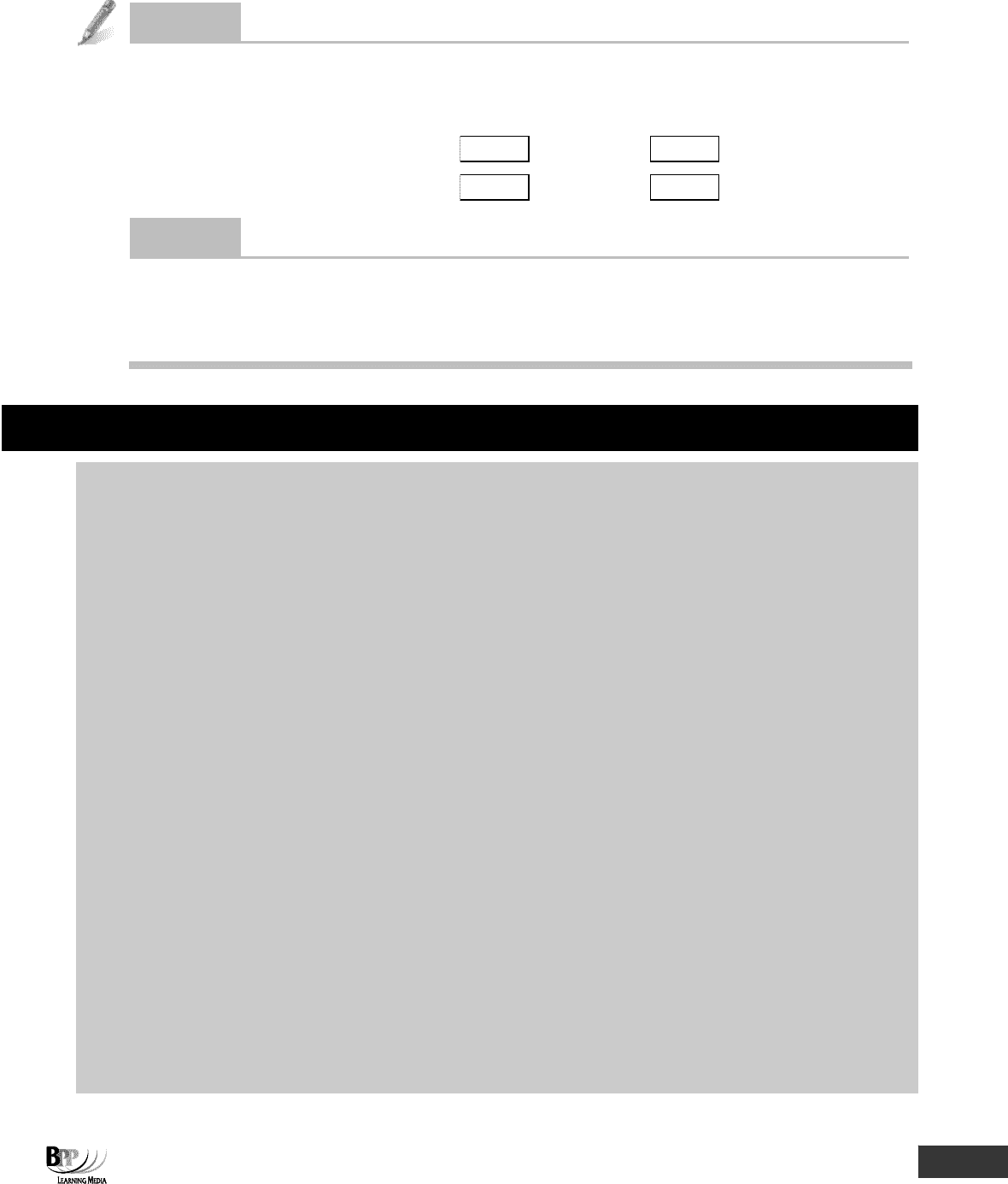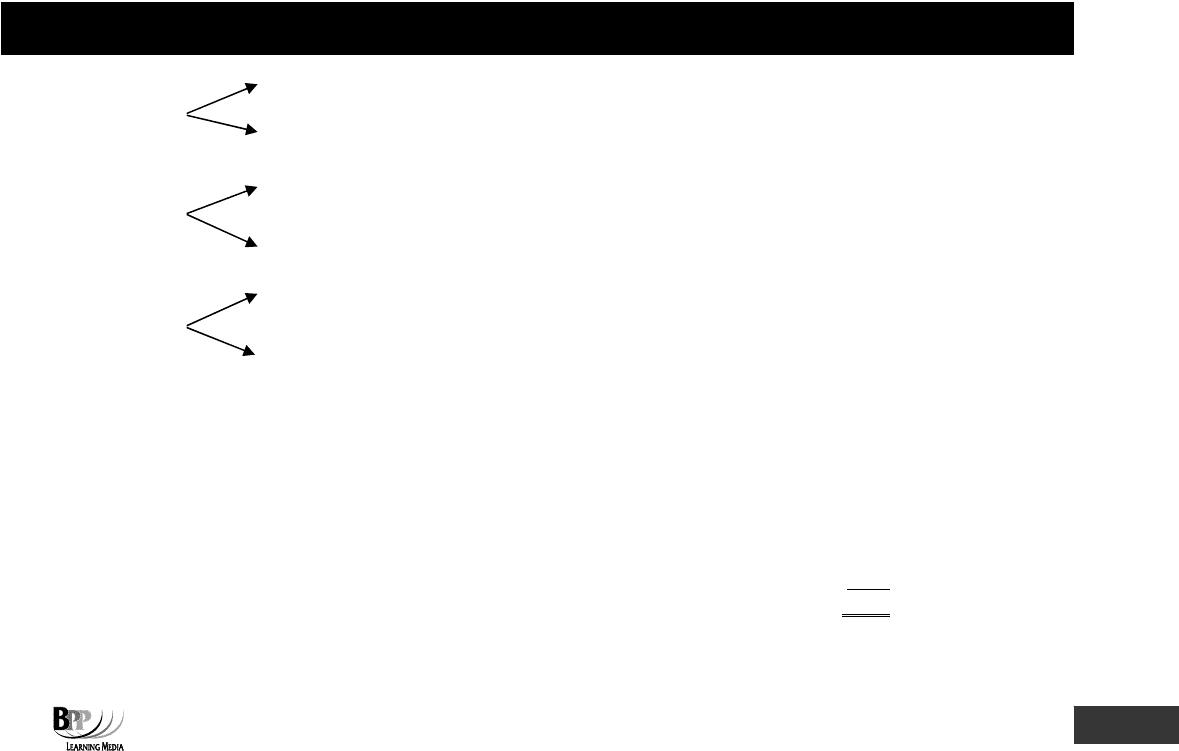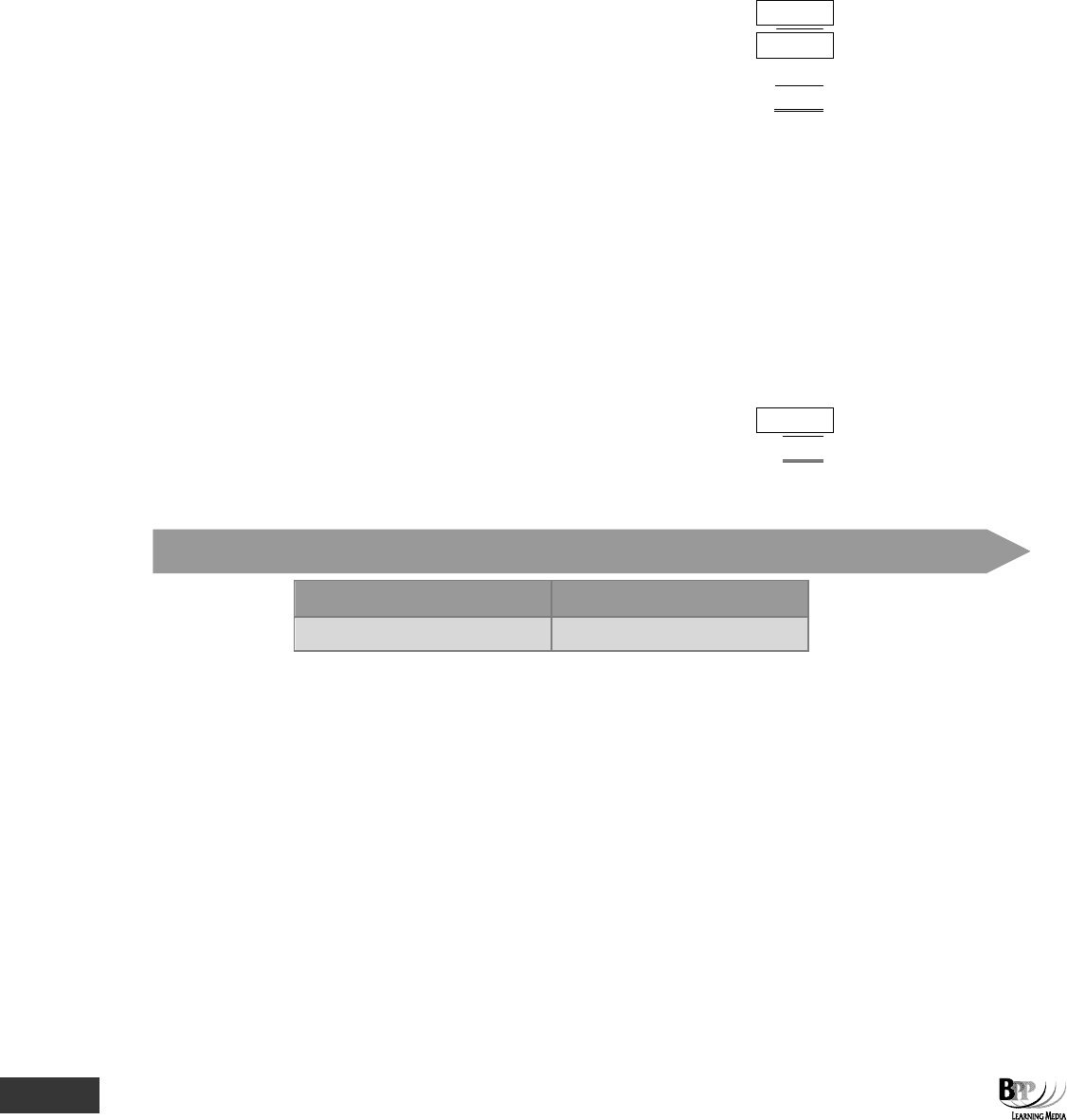CIMA - C1 Fundamentals of Management Accounting
Подождите немного. Документ загружается.


190
8: Variance analysis ⏐ Part B Standard costing
Actual direct wages cost $171,320. P Co paid $5.50 for each kg of direct material. There were no opening or closing
inventories of the material.
Required
Calculate the following.
(a) Actual output (c) Average actual wage rate per hour
(b) Actual hours worked (d) Actual number of kilograms purchased and used
Solution
(a)
$
Total direct wages cost
171,320
Adjust for variances:
labour rate
(10,598)
labour efficiency
8,478
Standard direct wages cost
169,200
∴
Actual output = Total standard cost
÷
unit standard cost
= $169,200
÷
$72
= 2,350 units
(b)
$
Total direct wages cost
171,320.0
Less rate variance
(10,598.0
)
Standard rate for actual hours
160,722.0
÷
standard rate per hour
÷ $12.0
Actual hours worked
13,393.5
hrs
(c) Average actual wage rate per hour = actual wages/actual hours = $171,320/13,393.5 = $12.79 per hour.
(d) Number of kgs purchased and used = x
$
x kgs should have cost (
×
$6)
6.0x
but did cost (
×
$5.50)
5.5x
Direct material price variance
0.5x
∴
$0.5x = $18,840
∴
x = 37,680 kgs
Question
Actual rate of pay
XYZ Co uses standard costing. The following data relates to labour grade ll.
Actual hours worked 10,400 hours
Standard allowance for actual production 8,320 hours
Standard rate per hour $5
Rate variance (adverse) $416
What was the actual rate of pay per hour?
A $4.95
B $4.96
C $5.04
D $5.05
211433 www.ebooks2000.blogspot.com

Part B Standard costing ⏐ 8: Variance analysis
191
Answer
The correct answer is C.
Rate variance per hour worked =
$416
10,400
= $0.04 (A)
Actual rate per hour = $(5.00 + 0.04) = $5.04.
You should have been able to eliminate options A and B because they are both below the standard rate per hour. If the
rate variance is adverse then the actual rate must be above standard.
Option D is incorrect because it results from basing the calculations on standard hours rather than actual hours.
Question
Quantity of material X
The standard material content of one unit of product A is 10kgs of material X which should cost $10 per kilogram. In
June 20X4, 5,750 units of product A were produced and there was an adverse material usage variance of $1,500.
The quantity of material X used in June 20X4 is
kgs.
Answer
The quantity used is
57,650
kgs
.
Workings
Let the quantity of material X used = Y
5,750 units should have used (
×
10kgs)
57,500 kgs
but did use
Y
kgs
Usage variance in kgs
(Y – 57,500) kgs
×
standard price per kg
× $10
Usage variance in $
$1,500
(A)
∴
10(Y – 57,500) = 1,500
Y – 57,500 = 150
∴
Y = 57,650 kgs
Make sure you can deal with this sort of variance analysis question as it is an ideal way of assessing your competence in
this area.
9 Inter-relationships between variances
In many cases, individual variances should not be looked at in isolation. One variance might be inter-related with
another, and much of it might have occurred only because the other, inter-related, variance occurred too.
When two variances are
interdependent
(
interrelated
) one will usually
be adverse and the other one favourable.
FA
S
T F
O
RWAR
D
Assessment
focus point
212433 www.ebooks2000.blogspot.com

192
8: Variance analysis ⏐ Part B Standard costing
Here are some examples of interdependent variables.
(a)
Materials price and usage
It may be decided to purchase cheaper materials for a job in order to obtain a favourable price variance,
possibly with the consequence that materials wastage is higher and an adverse usage variance occurs. If
the cheaper materials are more difficult to handle, there might be an adverse labour efficiency variance
too.
If a decision is made to purchase more expensive materials, which perhaps have a longer service life, the
price variance will be adverse but the usage variance might be favourable.
(b)
Labour rate and efficiency
If employees in a workforce are paid higher rates for experience and skill, using a highly skilled team to do
some work would incur an adverse rate variance, but should also obtain a favourable efficiency variance.
In contrast, a favourable rate variance might indicate a larger-than-expected proportion of inexperienced
workers in the workforce, which could result in an adverse labour efficiency variance, and perhaps poor
materials handling and high rates of rejects too (adverse materials usage variance).
(c)
Sales price and sales volume
The possible interdependence between sales price and sales volume variances should (hopefully) be
obvious to you. A reduction in the sales price might stimulate bigger sales demand, so that an adverse
sales price variance might be offset by a favourable sales volume variance. Similarly a price rise would
give a favourable price variance, but possibly at the cost of a fall in demand and an adverse sales volume
variance.
(d)
Cost and sales variances
(i) If there are
favourable cost variances
(perhaps cheaper labour or material have been used, say, so
that there are favourable labour rate or material price variances), the possible drop in quality of the
product could lead to an
adverse sales volume variance
because customers don’t wish to buy the
lower quality product.
(ii) If product quality is improved this might result in an
adverse cost variance
.
– If more expensive material is used (adverse material price variance)
– If labour are more careful in production of the product and hence take longer than standard
(adverse labour efficiency variance)
– If more skilled labour is used (adverse labour rate variance)
But the change in quality might result in a
favourable sales volume variance
, customers wanting
to buy more of the higher-quality product.
(iii) If costs have risen (resulting in
adverse labour rate, material price and variable overhead
expenditure variances
), the sales price might have to be increased to cover the extra costs. This
would result in a
favourable sales price variance
.
213433 www.ebooks2000.blogspot.com

Part B Standard costing ⏐ 8: Variance analysis
193
Question
Variance interrelationships
Hey Co has been let down by its supplier and has had to buy from an alternative source. The alternative materials are of
better quality but are more expensive than the original supplier's. What effect is this change in supplier likely to have on
the variances at the month end?
(a) Materials price variance Favourable
Adverse
(b) Materials usage variance Favourable
Adverse
Answer
Adverse, Favourable
The materials are more expensive which will lead to an adverse price variance. They are however, better quality which
means that the material usage variance should be favourable.
Chapter Roundup
•
Variances
measure the difference between actual results and expected results. t The process by which the total
difference between standard and actual results is analysed is known as
variance analysis
.
•
The
direct material total variance
(the difference between what the output actually cost and what it should have cost, in
terms of material) can be divided into the
direct material price
variance
and the
direct material usage
variance
.
•
Since material inventories are usually valued at
standard cost
in a standard costing system, direct material price
variances are usually extracted at the time of
receipt
of the materials, rather than at the time of usage.
•
The
direct labour total variance
(the difference between what the output should have cost and what it did cost, in terms
of labour) can be divided into the
direct labour rate
variance
and the
direct labour efficiency
variance
.
•
If idle time arises, it is usual to calculate a separate
idle time variance
, and to base the calculation of the
efficiency
variance
on
active hours
(when labour actually worked) only. It is always an
adverse
variance.
•
The
variable overhead total variance
can be subdivided into the variable overhead
expenditure
variance
and the
variable overhead
efficiency
variance (based on active hours).
•
There are a wide range of
reasons
for the occurrence of adverse and favourable cost
variances
.
•
The
sales price variance
is a measure of the effect on expected contribution of a different selling price to standard
selling price. It is calculated as the difference between what the sales revenue should have been for the actual quantity
sold, and what it was.
•
The sales volume variance in units is the difference between the actual units sold and the budgeted quantity. This
variance in units can be valued in one of three ways: in terms of standard revenue, standard gross margin or standard
contribution margin.
•
Operating statements
show how the combination of variances reconcile budgeted contribution and actual contribution.
•
Variances
can be
manipulated
so as to derive actual data from standard cost details.
•
When two variances are
interdependent (interrelated)
one will usually be adverse and the other favourable.
214433 www.ebooks2000.blogspot.com

194
8: Variance analysis ⏐ Part B Standard costing
Quick Quiz
1 Subdivide the following variances.
(a) Direct materials cost variance
(b) Direct labour cost variance
(c) Variable production overhead variance
2 What are the two main advantages in calculating the material price variance at the time of receipt of materials?
3 Adverse material usage variances might occur for the following reasons.
I Defective material
II Excessive waste
III Theft
IV Unforeseen discounts received
A I
B I and II
C I, II and III
D I, II, III and IV
4 Hat Co makes a product Kap which requires material budgeted at 50c per kg. During June, 6,200 kg were purchased for
$3,224 and 6,000 kg were used. There was no opening inventory at the start of June. Inventory is valued at standard
cost.
(a) Calculate the material price variance for June.
A $224 C $244
B $124 D $144
(b) Is the variance favourable or adverse?
Favourable
Adverse
5 A regular report for management of actual cost and revenue, and usually comparing actual with budget (and showing
variances) is known as
A Bank statement C Budget statement
B Variance statement D Operating statement
6 A favourable sales price variance can result from a combination of a lower than budgeted sales volume and a higher than
standard selling price.
True
False
7 If two variances are interdependent, both must be either favourable or adverse.
True
False
215433 www.ebooks2000.blogspot.com

Part B Standard costing ⏐ 8: Variance analysis
195
8 The sales volume variance considers the difference between ………………… sales volume and ………………… sales
volume.
Fill in the gaps using two of the following words.
•
total
•
budgeted
•
actual
•
future
•
incremental
•
estimated
•
past
•
confirmed
9 HF Co budgeted to produce 3,000 units of product K in June. The budgeted materials for product K were 1,500 kg at a
cost of $3 per kg. The actual number of units produced was 2,200 and the material variances were as follows:
Direct material price variance $825(A)
Direct material efficiency variance $1,650(A)
Calculate the actual direct material kgs used.
A 550 kg
B 1,100 kg
C 1,650 kg
D 4,950 kg
10 Using the information in question 10, calculate the actual direct material cost for June.
A $825
B $4,125
C $4,950
D $5,775
Answers to Quick Quiz
Price
1 (a)
Usage
Rate
(b)
Efficiency
Expenditure
(c)
Efficiency
2 (a) The earlier variances are extracted, the sooner they will be brought to the attention of managers.
(b) All inventories will be valued at standard price which requires less administration effort.
3 C Unforeseen discounts received would lead to a favourable price variance.
4 B $124 Adverse
$
6,200 kg should have cost (× 50c)
3,100
But did cost
3,224
124
(A)
5 D
216433 www.ebooks2000.blogspot.com

196
8: Variance analysis ⏐ Part B Standard costing
6 True. The variance is favourable if the actual price is higher than standard.
7 False. Favourable material price and adverse material usage variances might be interdependent, for example.
8 The correct words are
budgeted
and
actual
.
9 C First we write out the way we would normally calculate the material efficiency variance and fill in the figures that
we know.
2,200 units should have used (x 3,000/1,500kg)
1,100
kg
But did use
(Q)
Material efficiency variance in kgs
(P)
x standard cost per kg
x $3
$1,650
(A)
Working backwards we can see that the efficiency variance in kg (box (P))
= 1,650 ÷ $3
= 550 kg
Now that we know the efficiency variance in kg, we can work out the number of kg that were actually used (box
(Q))
= 550 kg + 1,100 kg
= 1,650 kg
10 D $5,775
1,650 kg should have cost (x $3) 4,950
But did cost
Materials price variance
825
(A)
Working backwards we can see that the actual cost must have been 825 + 4,950 = $5,775.
Now try the questions below from the Question Bank
Question numbers Page
37–46 359
217433 www.ebooks2000.blogspot.com

197
Part C
Financial planning and
control
218433
www.ebooks2000.blogspot.com

198
219433 www.ebooks2000.blogspot.com

199
Topic list
Learning outcomes
Syllabus references
Ability required
1 Why do organisations prepare budgets? E(i) E(1) Comprehension
2 A framework for budgeting E(i), (ii) E(1) Comprehension/
Application
3 Steps in the preparation of a budget E(i), (ii) E(2) Comprehension/
Application
4 Functional budgets E(ii) E(2) Application
5 Cash budgets E(iii), E(iv) E(2) Application, Analysis
6 Master budgets E(iii) E(2) Application
7 Capital expenditure budgets E(ii) E(2) Application
8 Approaches to budgeting E(i) E(1) Comprehension
Budget preparation
Introduction
This chapter is the first of two on a new topic, budgeting. It is a topic which you will meet at
all stages of your examination studies so it is vital that you get a firm grasp of the basics
now. The chapter begins by explaining the reasons why an organisation might prepare a
budget and goes on to detail the steps in the preparation of a budget. The method of
preparing and the relationship between the various functional budgets is then set out.
The chapter also considers the construction of cash budgets and budgeted income
statements and statements of financial position, the these three budgets making up what is
known as a master budget.
In Chapter 10 we will build on the general awareness of budgeting gained in this chapter and
look at more specific budgeting issues.
220433
www.ebooks2000.blogspot.com
